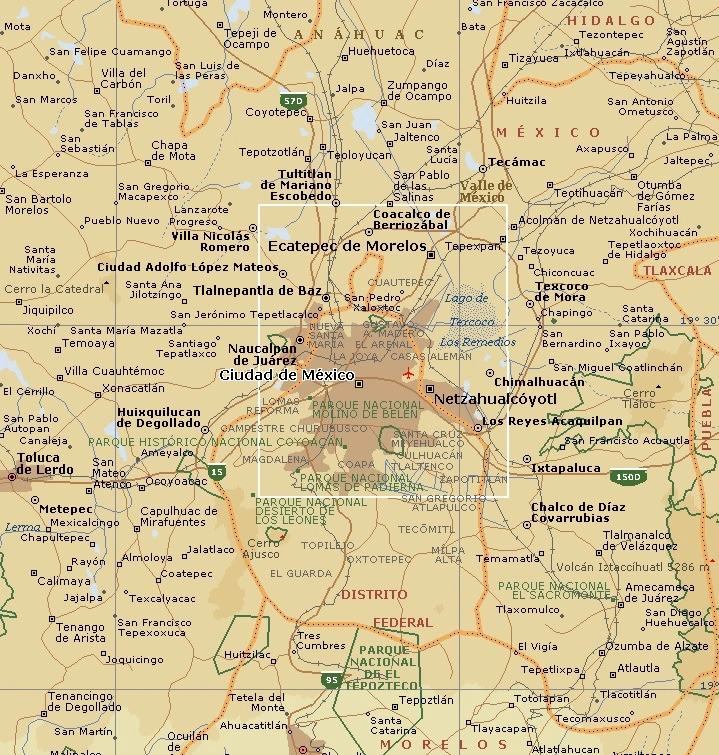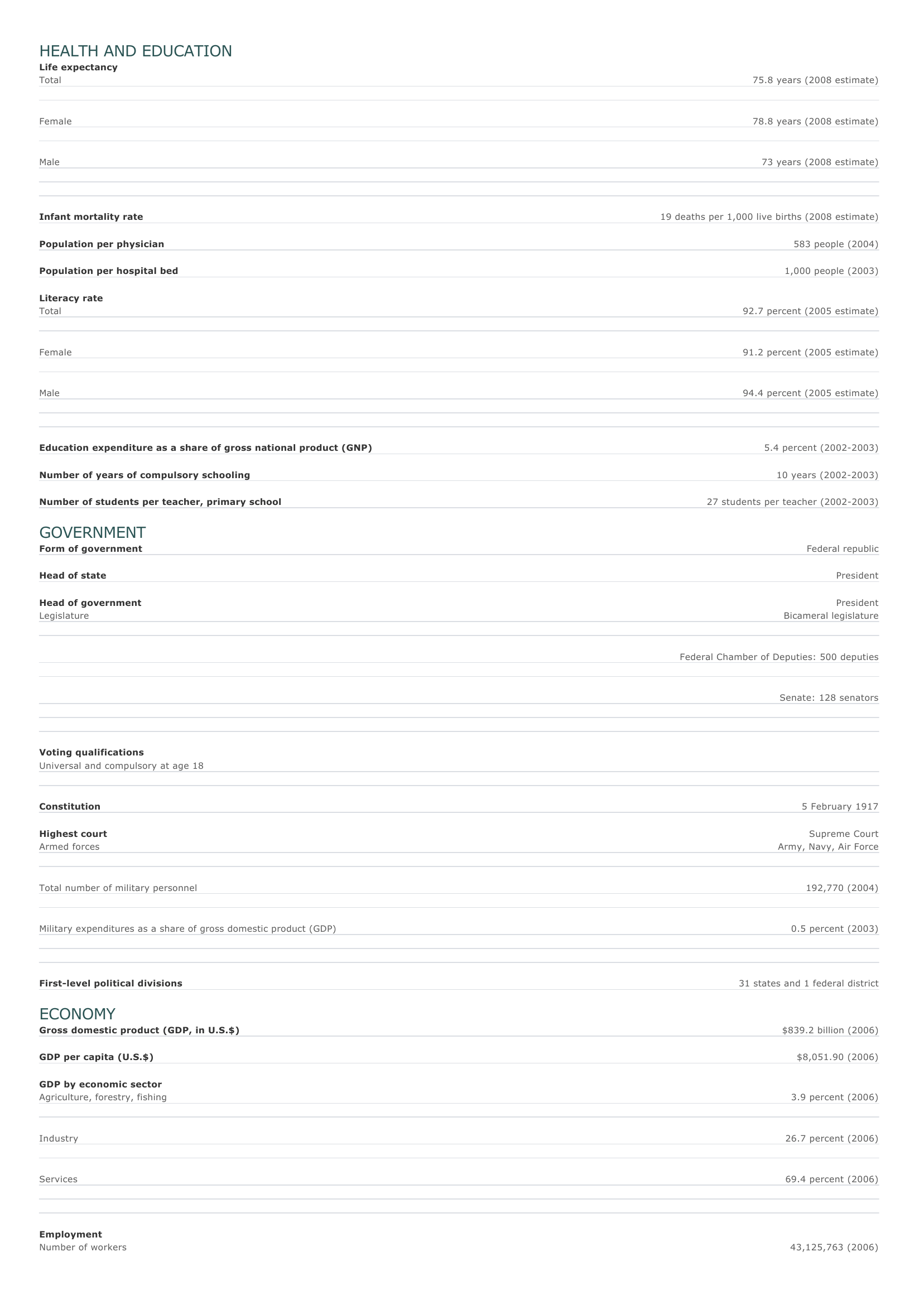
Mexico Facts and Figures. BASIC FACTS Official name Capital Area United Mexican States Mexico City 1,964,382 sq km 758,452 sq mi PEOPLE Population 109,955,400 (2008 estimate) Population growth Population growth rate 1.14 percent (2008 estimate) Projected population in 2025 130,198,692 (2025 estimate) Projected population in 2050 147,907,650 (2050 estimate) Population density 57 persons per sq km (2008 estimate) 148 persons per sq mi (2008 estimate) Urban/rural distribution Share urban 76 percent (2005 estimate) Share rural 24 percent (2005 estimate) Largest cities, with population Mexico City 18,660,221 (2003 estimate) Ecatepec de Morelos 1,723,987 (2008 estimate) Guadalajara 1,579,128 (2008 estimate) Puebla 1,474,789 (2008 estimate) Netzahualcóyotl 1,101,619 (2008 estimate) Ethnic groups Mestizo (Native American-Spanish) 60 percent Amerindian 30 percent European ancestry 9 percent O ther 1 percent Languages Spanish (official), various indigenous languages, English Religious affiliations Roman Catholic 89 percent Protestant 3 percent Nonreligious 3 percent O ther 5 percent HEALTH AND EDUCATION Life expectancy Total 75.8 years (2008 estimate) Female 78.8 years (2008 estimate) Male Infant mortality rate Population per physician Population per hospital bed 73 years (2008 estimate) 19 deaths per 1,000 live births (2008 estimate) 583 people (2004) 1,000 people (2003) Literacy rate Total 92.7 percent (2005 estimate) Female 91.2 percent (2005 estimate) Male 94.4 percent (2005 estimate) Education expenditure as a share of gross national product (GNP) Number of years of compulsory schooling Number of students per teacher, primary school 5.4 percent (2002-2003) 10 years (2002-2003) 27 students per teacher (2002-2003) GOVERNMENT Form of government Head of state Head of government Legislature Federal republic President President Bicameral legislature Federal Chamber of Deputies: 500 deputies Senate: 128 senators Voting qualifications Universal and compulsory at age 18 Constitution Highest court Armed forces Total number of military personnel Military expenditures as a share of gross domestic product (GDP) First-level political divisions 5 February 1917 Supreme Court Army, Navy, Air Force 192,770 (2004) 0.5 percent (2003) 31 states and 1 federal district ECONOMY Gross domestic product (GDP, in U.S.$) GDP per capita (U.S.$) $839.2 billion (2006) $8,051.90 (2006) GDP by economic sector Agriculture, forestry, fishing 3.9 percent (2006) I ndustry 26.7 percent (2006) Services 69.4 percent (2006) Employment Number of workers 43,125,763 (2006) Workforce share of economic sector Agriculture, forestry, fishing 15 percent (2005) I ndustry 26 percent (2005) Services 59 percent (2005) Unemployment rate 3 percent (2004) National budget (U.S.$) Total revenue $89,763 million (2000) Total expenditure $85,729 million (2000) Monetary unit 1 nuevo Mexican peso (Mex$), consisting of 100 centavos Agriculture Maize, beans, sugarcane, sorghum, wheat, barley, rice, oranges, coffee, tomatoes, potatoes, cotton, livestock Mining Petroleum and natural gas, silver, zinc, fluorite, copper, lead, salt, celestite, antimony, bismuth Manufacturing Motor vehicles, food products, iron and steel, chemicals, beverages, electrical machinery Major exports Crude petroleum, petroleum products, coffee, silver, internal combustion engines, motor vehicles, cotton, consumer electronics Major imports Metalworking machines, steel mill products, agricultural machinery, electrical equipment, automobile parts for assembly and repair, aircraft Major trade partners for exports United States, Canada, Germany, Spain, and Netherlands Antilles Major trade partners for imports United States, Japan, Germany, Canada, and China ENERGY, COMMUNICATIONS, AND TRANSPORTATION Electricity production Electricity from thermal sources 82.85 percent (2003 estimate) Electricity from hydroelectric sources 9.40 percent (2003 estimate) Electricity from nuclear sources 4.77 percent (2003 estimate) Electricity from geothermal, solar, and wind sources 2.97 percent (2003 estimate) Number of radios per 1,000 people 329 (1997) Number of telephones per 1,000 people 189 (2005) Number of televisions per 1,000 people 274 (2000 estimate) Number of Internet hosts per 10,000 people Daily newspaper circulation per 1,000 people Number of motor vehicles per 1,000 people Paved road as a share of total roads SOURCES Basic Facts and People sections 129 (2003) 94 (2000) 211 (2004) 50 percent (2004) Area data are from the statistical bureaus of individual countries. Population, population growth rate, and population projections are from the United States Census Bureau, International Programs Center, International Data Base (IDB) (www.census.gov). Urban and rural population data are from the Food and Agriculture Organization (FAO) of the United Nations (UN), FAOSTAT database (www.fao.org). Largest cities population data and political divisions data are from the statistical bureaus of individual countries. Ethnic divisions and religion data are largely from the latest Central Intelligence Agency (CIA) World Factbook and from various country censuses and reports. Language data are largely from the Ethnologue, Languages of the World, Summer Institute of Linguistics International (www.sil.org). Health and Education section Life expectancy and infant mortality data are from the United States Census Bureau, International Programs Center, International database (IDB) (www.census.gov). Population per physician and population per hospital bed data are from the World Health Organization (WHO) (www.who.int). Education data are from the United Nations Educational, Scientific and Cultural Organization (UNESCO) database (www.unesco.org). Government section Government, independence, legislature, constitution, highest court, and voting qualifications data are largely from various government Web sites, the latest Europa World Yearbook, and the latest Central Intelligence Agency (CIA) World Factbook. The armed forces data is from Military Balance. Economy section Gross domestic product (GDP), GDP per capita, GDP by economic sectors, employment, and national budget data are from the World Bank database (www.worldbank.org). Monetary unit, agriculture, mining, manufacturing, exports, imports, and major trade partner information is from the statistical bureaus of individual countries, latest Europa World Yearbook, and various United Nations and International Monetary Fund (IMF) publications. Energy, Communication, and Transportation section Electricity information is from the Energy Information Administration (EIA) database (www.eia.doe.gov). Radio, telephone, television, and newspaper information is from the United Nations Educational, Scientific and Cultural Organization (UNESCO) database (www.unesco.org). Internet hosts, motor vehicles, and road data are from the World Bank database (www.worldbank.org). Note Figures may not total 100 percent due to rounding. Microsoft ® Encarta ® 2009. © 1993-2008 Microsoft Corporation. All rights reserved.



































